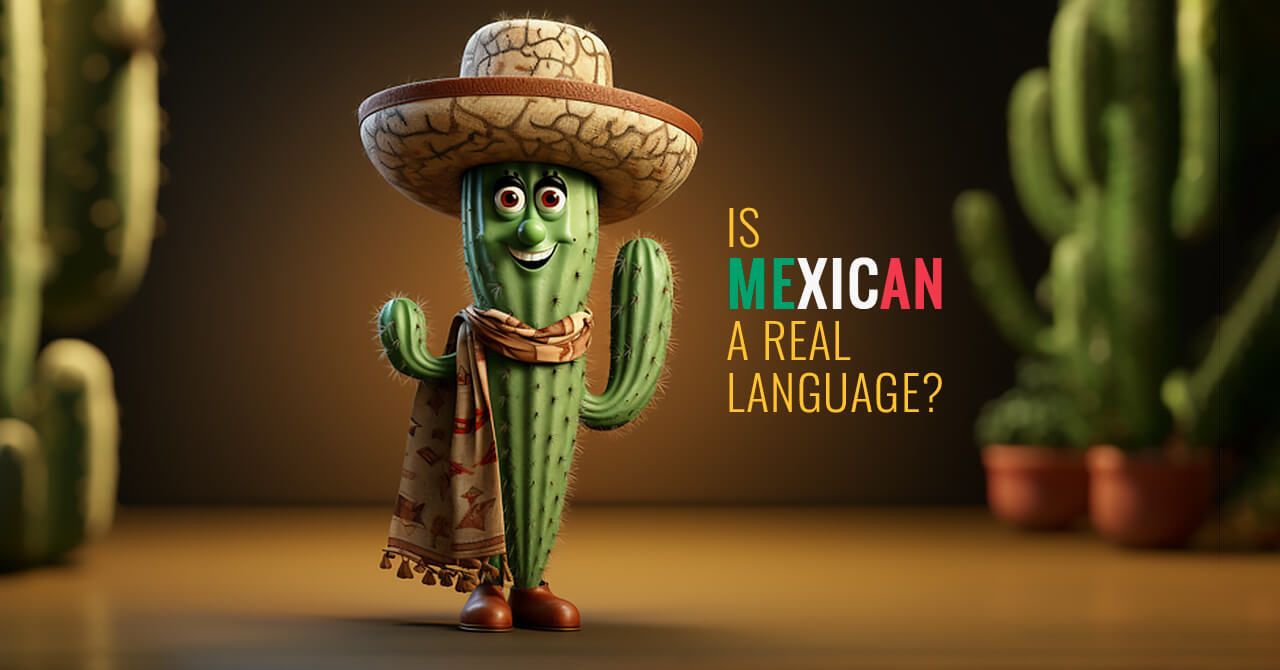
Spanish vs. Mexican: Is Mexican a Real Language, or Is Just Spanish?
In fact, there is no language called “Mexican.” However, there is a huge ecosystem of linguistic dialects in this Mexican vs. Spanish fight.
Here we find a dispute between: are Spanish and Mexican different languages? For a long time, some people who don’t speak Spanish believed that there is a language called Mexican, and that, of course, is spoken in Mexico. Truth being said: that language doesn’t exist. In fact, people speak Spanish in Mexico, and there are also some common indigenous languages in certain regions.
Mexico is undeniably one of the largest countries on the American continent and holds a prominent position as one of the most populous in the region. Spanning nearly 2 million square kilometers of territory, it accommodates over 130 million inhabitants, resulting in a harmonious coexistence of diverse languages and cultures. With its profound historical background, Mexico’s cultural wealth is equally vast. It stands as a crucible of different races, religions, idiosyncrasies, gastronomy, languages, and dialects, forming a tapestry of diversity.
In Mexico, a total of 69 official languages are recognized, with Spanish being the predominant one, alongside 68 indigenous languages. It is essential to note that none of these languages are referred to as “Mexican.” This aspect may come as a surprise, particularly to non-Spanish speakers who are not well-acquainted with Mexican culture, potentially leading to a misconception between nationality and language.
So, is Mexican a language? In fact, there is no language called “Mexican.” However, there is a huge ecosystem of linguistic dialects in this Mexican vs. Spanish fight. We are talking about languages and idioms in the country that coexist with each other. Therefore, let’s dig into the mysteries of this fascinating country and its linguistic richness.
Difference between Spanish and Mexican: there is no “Mexican” language
Many countries, especially major powers, have an official language that bears the same name as their demonym. For instance, French is spoken in France, English in England, and Japanese in Japan. Perhaps due to this association, some individuals might mistakenly assume that the language spoken in Mexico is called “Mexican.” But that’s not how it is in reality. There is no language designated as such, just as there are no “Peruvian,” “Panamanian,” or “Colombian” languages.
Instead, there is a Spanish variation known as “Mexican Spanish,” which possesses distinct linguistic and lexical characteristics unique to Mexico. For example, the Spanish spoken in this country is characterized by a lyrical intonation and the inclusion of indigenous words specific to the region.
Also, while Spanish is the predominant language in Mexico, it is not the sole one spoken in this North American nation. In fact, the Mexican constitution officially recognizes not only Spanish but also 68 indigenous languages as well. This is really impressive.
“Mexican” as a variant of the Spanish language
Despite Mexican Spanish having its peculiarities, it is merely a variant of the Spanish language. This means that both in neighboring countries like Guatemala and on the other side of the continent, in Argentina, the same language as in Mexico is spoken.
Can Spaniards understand Mexican Spanish? In a conversation among a Mexican, a Guatemalan, an Argentine, and a Spaniard, these four individuals will understand each other very well. At times during the conversation, certain idioms, regional expressions, or accent peculiarities from each one of them may cause some confusion (just like Australian, British, and American English). However, the Spanish language serves as a common bond that enables these individuals to communicate fluently with one another.
In addition to idioms and the incorporation of Nahuatl or Mixtec words (such as “cacahuate,” for “peanuts”; or “cuate” for “friend,” for instance), Mexican Spanish exhibits a range of linguistic particularities. In fact, the “s” sound at the end of syllables and words is retained, unlike in Caribbean Spanish. Another peculiarity is the frequent use of diminutives.
Nahuatl and some other Mexican languages
As mentioned earlier, Spanish is the predominant language in Mexico, but it is not the only one. There are 68 languages recognized as official under the Law of Linguistic Rights of Indigenous Peoples. This means that these languages have legal validity throughout Mexican territory and boast many speakers. It is estimated that approximately 6 million Mexicans speak one of these languages.
These languages carry significant historical weight, dating back to pre-Columbian times, and have persisted despite the cultural prominence of Spanish. The most widely spoken language in Mexico, apart from Spanish, is Nahuatl, the language of the ancient Aztec empire. Nahuatl has been a pillar of Mexican culture, preserving the traditions of indigenous communities.
Linguistically rich, Nahuatl has witnessed the creation of significant literary works, such as Fray Bernardino de Sahagún’s “General History of the Things of New Spain.” Written in the 16th century, the work is composed in Nahuatl, with fragments in Spanish and Latin. It compiles information about the life, culture, and traditions of pre-Hispanic Mexico.
Presently, Nahuatl boasts more than 3 million speakers, most of whom are bilingual. It represents an essential heritage of Mexican culture, deserving preservation and promotion through education.
There are some other common languages as:
- Mixtec: Spoken in the southern states of Oaxaca, Guerrero, and Puebla.
- Zapotec: Throughout Mexico’s southern region, mainly in Oaxaca.
- Otomi: Populations in central Mexico speak it.
- Totonac: In eastern Mexico, primarily in Veracruz.
- Mazatec: Spoken in northern Oaxaca.
- Tzeltal: The Mayan language is spoken in the Chiapas highlands.
- Tzotzil: Another Mayan language spoken in Chiapas.
- Huastec: Spoken in the states of Veracruz, San Luis Potosi, and Tamaulipas in northeastern Mexico.
Fun differences between Castilian and Mexican Spanish
We are talking about a universe of linguistics here. But let’s have a look at the differences between these dialects:
- Vocabulary: Yes, Mexican Spanish was strongly influenced by indigenous words, and nowadays, due to the proximity to the US, English has a big influence on the dialect as well. But getting back to the most traditional Mexican Spanish, it contains many vocabularies acquired from Nahuatl and other indigenous languages that are not found in Castilian Spanish.
- Pronunciation: Mexican Spanish has one of the most recognizable tones for Spanish speakers. It has a softer and more melodic pronunciation than Castilian Spanish, which is crisp and official.
- Regionalisms: Actually, both dialects contain distinct regional expressions, although due to the country’s numerous cultural influences, Mexican Spanish has a greater spectrum of regionalisms.
- Formality: In some social situations, Mexican Spanish is less formal than Castilian Spanish, with tú (informal “you”) being used more frequently than the formal usted (formal “you”). In fact, many Latin American countries choose less formality in their own dialects compared to Spain.
Some ancient languages in Mexico
Other ancient languages that have persisted to the present day in Mexico include Yucatec Maya, Mixtec, Tarahumara, among others. For instance, Maya remains an important family language today, particularly in the Yucatan Peninsula and other southeastern regions of Mexico.
In contrast to the mentioned languages that have managed to endure over time, several ancient languages were not as fortunate. One of the most emblematic examples is Classical Maya. This language, represented through hieroglyphic inscriptions, dates back to 200 AD and was widely spoken in Mexican territory for several centuries.
Similarly, Classical Nahuatl, which served as the lingua franca in much of Mesoamerica during pre-Hispanic times, eventually disappeared. Currently, philologists and linguists have succeeded in deciphering codices and other texts in these languages, allowing us to gain a clearer understanding of the way of life of these ancient civilizations.
A historical overview: the influence of the Spanish language in Mexico
Culture is the key to understanding Mexico’s amazing history and linguistic change. For starters, the territory we now know as Mexico has always been a scene of marked linguistic diversity.
The pre-Hispanic peoples developed multiple languages and dialects, which either disappeared or evolved due to the influence of dominant languages, such as Classical Nahuatl.
Similarly, after the arrival of the conquistadors, many pre-Hispanic languages vanished, while others evolved through contact with Spanish. Upon their arrival in the 16th century, the conquistadors aimed to Hispanicize indigenous peoples. Linguistic diversity was perceived as a barrier to Christianization and social integration.
The colonization process resulted in a blending of linguistic elements from Spanish and indigenous languages, giving rise to a variety of Spanish with a pronounced indigenous influence. Over time, this variety has evolved into what we know as “Mexican Spanish,” adopting elements from other languages.
This linguistic fusion not only reflects the complex historical interactions between Spanish and indigenous cultures but also contributes to the rich and vibrant cultural tapestry that defines Mexico today.
Linguistic contact: Mexican Spanish and its linguistic borrowings
During the Latin American colonization, many countries were points of contact with the European world. Countries like Mexico, Colombia, Cuba, and Venezuela, thanks to their territorial wealth and easy maritime access, quickly became countries where many linguistic contacts took place.
Cuba, Colombia, or Venezuela are, perhaps, highly emblematic cases when it comes to linguistic contact. During the colony, the assimilation of the Spanish language occurred very quickly since its indigenous population was, unfortunately, decimated with speed, allowing this linguistic contact to become more of an imperial imposition of the language.
However, Mexico is one of the most striking cases. Despite the Spanish predominance during the conquests, the Mexican indigenous population was predominant. To such an extent that many of their languages were lingua francas at the time, like Nahuatl, and many of these words are still preserved today. But linguistic contact occurs in the crossing of local languages with Spanish and the evolution of a local dialect.
Language is always changing. If we were to read a document from the 16th century, we would observe that Spanish was not what it is today. Some words evolve with time, while others fall out of use and perish, and new words enter the language. This evolution is frequently facilitated by language borrowing.
Linguistic borrowing happens when one language, such as Spanish, adopts expressions from another, such as Nahuatl in the past or English these days. These terms are altered to fit the writing and pronunciation of the language that adopts them as they are adopted from another language. Nahuatl and other indigenous languages have had a substantial influence on Mexican Spanish, giving rise to familiar vocabulary such as “tomate” (tomato) and “chocolate.”
In the end, Mexican is not a language per se
Exactly, there is no language called “Mexican.” The dispute between Spanish versus Mexican doesn’t actually exist, these are just two versions of the same language. This language is basically Mexican Spanish. Perhaps it is correct to say the predominant language in Mexico is Spanish. However, there is a wide number of indigenous languages that still exist, and several communities speak such languages.
Mexico is a very big and rich territory with linguistic contacts. Those contacts are also part of what we call “Mexican.” But, in reality, Mexico is one of many countries that speak Spanish, and this dialect is an amazing and interesting variation in the continent.
Given its vast territory, its high population density, its extensive history, and its cultural richness, it is obvious that Mexico is equally rich linguistically. Despite this, many people have yet to learn about this diversity. They may even come to think that only one language is spoken, “Mexican.”
It is important to educate about the Mexican linguistic richness, understanding as a starting point that there is no “Mexican” language other than Spanish. What is spoken in Mexico is a variant of Spanish that reflects the historical and cultural richness of this country. It is a unique variant, different from the Spanish of Costa Rica, El Salvador, or Nicaragua, for example. This Spanish coexists, in addition, with dozens of other languages of equal richness.
I'm from Argentina and I'm bilingual. I speak both English and Spanish as native languages. I'm a content writer with extensive experience.

